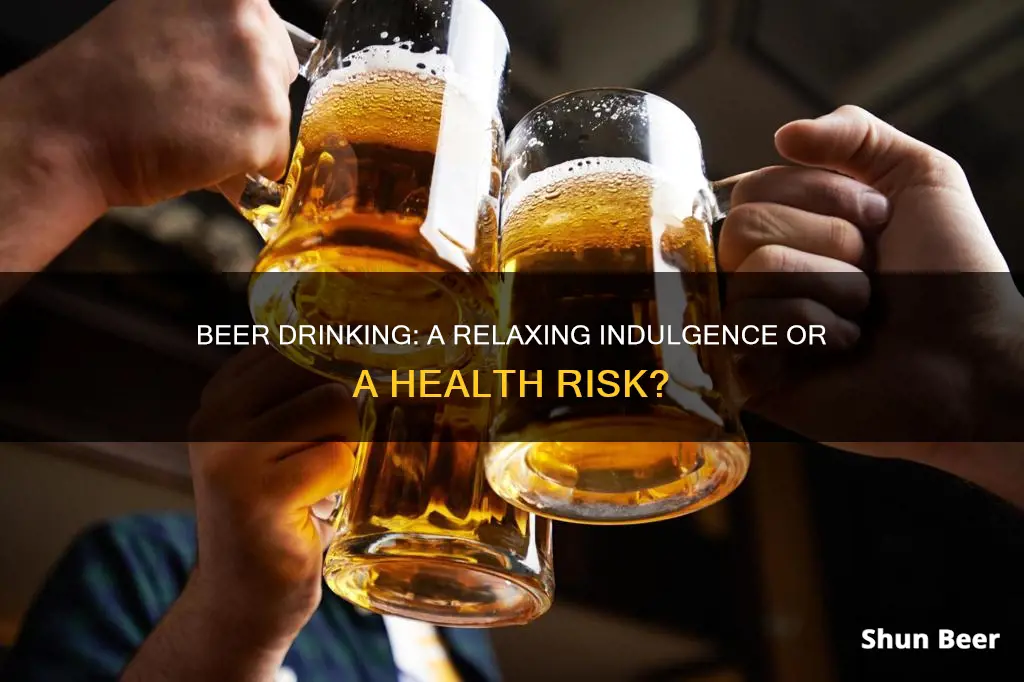
Beer is one of the world's most popular alcoholic beverages, with a history of consumption that dates back thousands of years. Today, it is widely consumed and celebrated globally, with some of the largest beer festivals attracting millions of visitors annually. While moderate beer consumption may offer certain health benefits, excessive drinking can lead to various negative health consequences and increase the risk of alcohol dependence. So, when you ask, Are you drinking a beer? it's essential to consider the context and amount of consumption to understand its potential impact on health and well-being.
| Characteristics | Values |
|---|---|
| Alcohol by volume (ABV) | 4-6% on average, but can range from 0.5-40% |
| Calories | 153 calories in a standard 12-ounce (355 mL) beer |
| Vitamins and minerals | Contains magnesium, potassium, selenium, calcium, thiamine, iron, zinc, and B vitamins |
| Antioxidants | Contains antioxidants from hops; darker beers tend to have more antioxidants |
| Health benefits | May benefit heart health, blood sugar control, bone density, and reduced dementia risk in moderate amounts |
| Health risks | Heavy drinking can increase the risk of depression, weight gain, liver disease, cancer, stroke, and early death |
| Social impact | Beer has been important in human culture for thousands of years and is often associated with community and social gatherings |
What You'll Learn

Beer and health: the pros and cons
Beer is one of the oldest beverages in the world, with recipes found in Egyptian tombs, Mesopotamian archaeological sites, and Babylonian texts. Today, it is one of the most popular alcoholic drinks globally, with a large number of individuals consuming it. Beer is made by fermenting grain into alcohol, using barley, hops, water, and yeast as its major components.
While science supports some of the health claims associated with moderate beer consumption, it is essential to understand the pros and cons of drinking beer to make an informed decision. Here is a detailed look at the potential benefits and drawbacks of drinking beer:
Pros:
- Heart Health: Several studies suggest that drinking one to two beers a day may help lower the risk of heart disease. Beer may be as effective as wine in improving general heart health at comparable alcohol levels.
- Blood Sugar Control: Light to moderate alcohol intake may help reduce the risk of developing diabetes and improve blood sugar control for people with diabetes.
- Bone Density: Early research suggests that moderate amounts of beer may help strengthen bones for men and postmenopausal women.
- Dementia Risk: Light to moderate alcohol intake may lower the risk of dementia.
- Convenience and Accessibility: Beer is widely available and tends to be more affordable than other alcoholic drinks, making it a convenient option for social gatherings and celebrations.
- Refreshment: Beer is considered refreshing, especially on hot days, providing a soothing effect.
Cons:
- Addiction: All alcohol, including beer, carries the potential for dependency and addiction. Heavy drinking eliminates most health benefits and increases the risk of alcohol use disorder.
- Reduced Life Expectancy: Heavy consumption of alcohol, including beer, significantly increases the risk of early death from all causes. Studies show that heavy drinking can reduce life expectancy by up to 28 years.
- Liver Disease: Drinking more than the recommended amount of beer per day can increase the chances of developing fatty liver disease or cirrhosis.
- Weight Gain: Beers are often high in calories, and frequent consumption can lead to substantial weight gain, commonly known as a "beer belly."
- Sleep Disruption: Alcohol affects the brain's communication pathways and impairs sleep quality, even when consumed in light amounts.
- Digestive Issues: Alcohol irritates the small intestine and colon and can affect the normal speed of food movement, leading to abdominal pain, bloating, and diarrhea.
- Increased Risk of Chronic Diseases: Excessive drinking increases the risk of high blood pressure, stroke, heart failure, and cardiomyopathy.
- Cancer Risk: Research associates any alcohol intake with an increased risk of cancers, including throat, mouth, liver, and breast cancers.
In conclusion, while moderate beer consumption may offer some potential health benefits, heavy drinking or binge drinking eliminates these benefits and is associated with negative health consequences. It is essential to consume alcohol in moderation and responsibly, always following recommended daily intake guidelines.
Drinking Beer in Malaysia: What's the Deal?
You may want to see also

Beer and addiction
Beer is the most popular alcoholic drink in the United States, with the average American consuming about 68 litres (18 gallons) in 2021. Beer typically has a lower alcohol content than other alcoholic drinks, but drinking too much beer can still lead to addiction and cause a number of health risks.
A beer addiction can start off fairly innocuously, perhaps as a way to unwind or socialise with friends or coworkers. However, if you are unable to control the amount you drink, you may be at risk of developing an addiction.
Signs that you may have a beer addiction include:
- Thinking about beer constantly, even when you are not drinking
- Being unable to control the amount of alcohol you consume
- Participating in binge drinking (4 or more beers in one sitting)
- Drinking more than is considered healthy (more than 2 beers per day or 8-12+ beers per week)
- Experiencing negative consequences in other areas of your life, such as work or relationships, due to your drinking
- Experiencing withdrawal symptoms and strong cravings for beer when you try to quit
The effects of beer addiction can be both physical and psychological. Ethanol, the main component of alcohol, can cause physical and psychological dependence by creating a depressant effect in the central nervous system and promoting the formation of positive memories associated with drinking.
Beer addiction is a type of alcohol use disorder (AUD), which is characterised by a loss of control over drinking and a negative emotional state when not consuming alcohol. AUDs can range from mild to severe and are influenced by various factors such as age, weight, gender, and the amount of alcohol consumed.
Treatment for beer addiction typically begins with a detox program to flush alcohol from the system, followed by therapy and support groups to teach coping skills and provide a supportive community. It's important to note that relapse rates for alcohol addiction are similar to those of other chronic diseases like diabetes and hypertension, so a comprehensive and individualised approach to treatment is crucial.
Weed Beer: How Does It Work?
You may want to see also

Beer and weight gain
Beer is often associated with weight gain, particularly around the belly, which is commonly referred to as a "beer belly". While moderate drinking may have some health benefits, such as improved heart health and blood sugar control, excessive alcohol consumption can lead to weight gain, among other negative health consequences.
- Increased Calorie Intake: Beer contains a significant number of calories. A standard 12-ounce (355-millilitre) beer contains around 153 calories. Regularly consuming multiple drinks can lead to excess calorie intake, which can result in weight gain.
- Preventing Fat Burning: Alcohol is prioritised by the liver for breakdown over other sources of fuel, including stored fat. This can interfere with the body's ability to burn fat, potentially leading to an increase in body fat over time.
- Phytoestrogen Content: Beer is flavoured using hops, which are high in phytoestrogens, plant compounds that can mimic the female sex hormone oestrogen. It has been suggested that the hops in beer may cause hormonal changes in men that increase the risk of storing belly fat. However, the exact effects of phytoestrogens on weight or belly fat are not yet known.
To minimise the risk of weight gain, it is recommended to limit alcohol intake to moderate levels and lead a healthy, active lifestyle. This may include avoiding binge drinking, pairing beer with healthier food choices, rotating with non-alcoholic or alcohol-free options, and prioritising quality over quantity when it comes to beer selection.
Miller Beer Text Rebates: How Do They Work?
You may want to see also

Beer and socialising
Beer is one of the most popular alcoholic drinks worldwide. It is a drink made by fermenting sugars from starches, with barley, hops, water, and yeast as its major components. It can be alcoholic or non-alcoholic.
Beer has been important in human culture for thousands of years. It is often consumed during celebrations and social gatherings, such as the annual Oktoberfest in Munich, which attracts about 6 million visitors who consume more than 7 million liters of beer.
Beer is also associated with sports and is commonly consumed at sporting events, especially in the United States. According to a University of Minnesota study, 48% of fans drink at sporting events, with 82% of those who tailgate consuming at least two alcoholic drinks. Beer is also heavily marketed and sponsored by sports leagues, further associating it with sports culture.
The consumption of beer can have both positive and negative effects on health. Light to moderate beer intake, typically defined as one to two drinks per day for women and one to four drinks per day for men, has been linked to several potential health benefits:
- Lower Risk of Heart Disease: Several studies suggest that light to moderate beer intake may reduce the risk of heart disease, possibly due to its ability to improve antioxidant properties and the body's ability to remove cholesterol.
- Improved Blood Sugar Control: Light to moderate alcohol intake may help reduce the risk of developing type 2 diabetes and improve blood sugar control in people with diabetes.
- Increased Bone Strength: Early research suggests that moderate amounts of beer may help strengthen bones for men and postmenopausal women.
- Improved Memory and Thinking Skills: Drinking one alcoholic beverage daily has been linked to improved memory and thinking skills in older males.
However, heavy and binge drinking of beer can lead to several negative health consequences:
- Potential for Addiction: Alcohol is an addictive substance, and heavy drinking can lead to alcohol dependence or alcohol use disorder.
- Reduced Life Expectancy: Heavy consumption of alcohol is associated with a higher risk of early death, with studies showing a reduction in life expectancy of up to 28 years.
- Increased Risk of Liver Disease: Drinking more than the recommended amount of beer can increase the chances of developing fatty liver disease or cirrhosis.
- Weight Gain: Beer is typically high in calories, and frequent consumption can contribute to weight gain, often referred to as "beer belly."
- Digestive Issues: Alcohol can irritate the gastrointestinal tract, leading to abdominal pain, bloating, and diarrhea.
- Increased Risk of Chronic Diseases: Excessive drinking increases the risk of high blood pressure, stroke, heart failure, and certain types of cancer, including mouth, throat, liver, and breast cancer.
It is important to note that the potential health benefits of beer are only associated with light to moderate consumption. Excessive drinking can negate these benefits and lead to serious health problems.
Drinking Beer in Public: What's Legal in Illinois?
You may want to see also

Beer and sport
Beer is also commonly consumed at sporting events. Fans typically consume 3.7 drinks, with a slight tendency to drink more at the event due to the festive atmosphere. While this may sound like binge drinking, it is important to consider that these events can last for three to four hours.
Beer companies have recognised the link between beer and sports and often advertise during sports programming to reach a wider audience and increase sales. In 2022, beer brands spent approximately $760 million on advertising, although this was a slight decrease from the previous year.
The association between beer and sports is also evident in the emergence of "performance beers" or "functional beers", which are crafted to aid athletes in celebrating, recovering, and refuelling for their next workout. For example, Sufferfest, a beer brand created by trail runner Caitlin Landesberg, offers a range of beers that are low in gluten and brewed with ingredients like black currant and salt to supply electrolytes and sugars that runners crave.
In addition to Sufferfest, other beer companies have also ventured into the world of functional beer. Dogfish Head has introduced "active lifestyle beers" such as SeaQuench Ale, a sour beer with lime and sea salt. Harpoon Brewery has released Rec League, a "recovery beer" brewed with sea salt and chia seeds, while Avery Brewing has debuted Go Play IPA, which contains sodium and potassium.
Beer and Basketball: Drinking Culture at UofA
You may want to see also
Frequently asked questions
Drinking one to two beers a day may help lower your risk of heart disease and improve blood sugar levels. Beer is also a good source of vitamins and minerals, and some beers contain antioxidants. However, heavy drinking eliminates most health benefits.
All alcohol carries the potential for dependency and addiction. Heavy drinking, or consuming more than two beers per day, can lead to significant health risks, including liver disease, weight gain, and a reduced life expectancy of up to 28 years.
In the United States, a standard drink of beer is typically defined as 12 ounces of regular beer, which is usually around 5% alcohol. However, different types and brands of beer can vary in their alcohol content, so it's important to check the label.







